|
The purpose of this article is not to show
another form of healing device, but to show the discoveries and cures
Royal Rife made with his apparatus half a century ago. He was a well
known scientist because of his breakthrough invention of an extremely
powerful microscope and he was very successful in curing certain
diseases. He was highly regarded within the scientific community until
the medical establishment came down on him and erased him from history.
At present there are several attempts in reconstructing his ray tube
healing device, but these remain experimental as the original details of
Royal Rife's equipment have been lost. Nevertheless it is a fascinating
story that gives us a different perspective on what microbes are, and a
way to eradicate them.
Biography of Royal
Rife
Born 1888 in Elkhorn, Nebraska, he served in the
Navy during World War I and was sent to investigate foreign
laboratories. He was a brilliant scientist who invented the equipment he
needed, if it did not exist. In 1929 he built a microscope capable of
staining living viruses with light to make them visible
(bioluminescence). Also the first micromanipulators, micro-dissectors
and heterodyning ultraviolet microscopes. In the process he won 14
government awards for scientific discoveries and a honorary medical
degree from the University of Heidelberg.
His work was supported
by millionaires such as Henry Timken. He invented the Universal
Microscope with which he became the first person to see a living virus.
Rife then identified the human cancer virus and named it “Cryptocides
Primordiales”. He inoculated 400 laboratory animals which created tumors
in each one. By using his resonance device he eliminated every cancer
tumor.
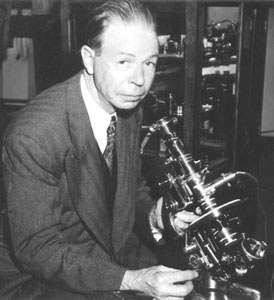
In 1934 Rife and a team of doctors and scientists from leading
medical research facilities cured 16 out of 16 cancer patients using the
Frequency Machine. Over the next four years the instruments and methods
were refined. Some of North America's most brilliant cancer researchers
visited Rife's laboratory and became involved in a research committee at
U.S.C.
Clinical proof of successful and painless cures from
cancer and other microbe-caused diseases increased as clinics in Los
Angeles and San Diego slowly documented cases. Additional laboratory
verification came from research institutions in San Francisco, Chicago,
New Jersey and Montreal. By the late 1930s, energy medicine doctors,
using a variety of different electronic approaches, grew in numbers and
had formed national associations.
However, the threat to orthodox
medicine was too great. Medical officials and societies mounted a
furious counterattack against Rife's monumental discovery before the
American public could be informed of it. Doctors who were using Rife's
instruments to treat cancer and other diseases were threatened with
losing their licenses and being thrown into jail. Most surrendered. An
energy medicine laboratory complex, which was in the process of
verifying Rife's discoveries, was mysteriously burned down, while the
owner was in California visiting Rife !
Rife was hauled into
court, prevented from leaving for England where leading scientists were
prepared to establish an independent testing facility to substantiate
the great discovery, and distribute his unique instruments worldwide.
All medical journals were censored and one of the greatest scientific
and medical discoveries of the 20th century was ruthlessly shoved into a
dungeon of history.
Rife's Revolutionary
Microscopes
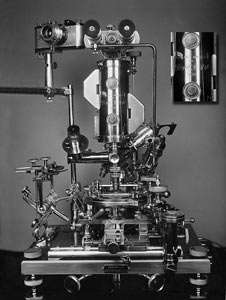
Royal Rife first started with creating
microscope that could bring better and more magnification than those in
existence. Because normal microscopes have limitations due to their
optics, he invented a whole new way of magnification. Thus he invented
the so-called Universal Prismatic Microscope. It consisted of 5,682
parts and able to achieve resolutions of up to 100,000 diameters.
(Typical magnification of a normal light microscope, assuming visible
range light, is up to 1500x, and it has limited depth of field)
By 1920, Royal Rife had finished building the world's first high
magnification microscope with which life viruses could be seen. By 1933,
he had perfected that technology and had constructed the incredibly
complex Universal Microscope, which had nearly 6,000 different parts and
was capable of magnifying objects 60,000 times their normal size! With
this incredible microscope, Rife became the first human to actually see
a live virus, and until quite recently, the Universal Microscope was the
only one which was able view live viruses.
Modern electron
microscopes (which can go up to 1,000,000X) instantly kill everything
beneath them, viewing only the mummified remains and debris. What the
Dr. Rife microscope can see is the bustling activity of living viruses
as they change form to accommodate changes in environment, replicate
rapidly in response to carcinogens, and transform normal cells into
tumor cells.
But how was Rife able to accomplish this, in an age
when electronics and medicine were still just evolving? Here are a few
technical details. Rife painstakingly identified the individual
spectroscopic signature of each microbe, using a slit spectroscope
attachment. Then, he slowly rotated block quartz prisms to focus light
of a single wavelength upon the microorganism he was examining. This
wavelength was selected because it resonated with the spectroscopic
signature frequency of the microbe based on the now-established fact
that every molecule oscillates at its own distinct frequency.
The
atoms that come together to form a molecule are held together in that
molecular configuration with a covalent energy bond which both emits and
absorbs its own specific electromagnetic frequency. No two species of
molecule have the same electromagnetic oscillations or energetic
signature. This allows frequencies to be directed at just the exact
microbe attacking the body, without harming any other tissue or
organisms. Resonance amplifies light in the same way two ocean waves
intensify each other when they merge together.
The result of
using a resonant wavelength is that micro-organisms which are invisible
in white light, suddenly become visible in a brilliant flash of light
when they are exposed to the color frequency that resonates with their
own distinct spectroscopic signature. Dr. Royal Rife was thus able to
see these otherwise invisible organisms and watch them actively invading
tissue cultures. Dr. Royal Rife's discovery enabled him to view
organisms that no one else could see with ordinary microscopes.
More than 75% of the organisms Rife could see with his Universal
Microscope are only visible with ultra-violet light. But ultraviolet
light is outside the range of human vision, it is 'invisible' to us. Dr.
Royal Rife's brilliance allowed him to overcome this limitation by
heterodyning, a technique which became popular in early radio
broadcasting. He illuminated the microbe (usually a virus or bacteria)
with two different wavelengths of the same ultraviolet light frequency
which resonated with the spectral signature of the microbe. These two
wavelengths produced interference where they merged. This interference
was, in effect, a third, longer wave which fell into the visible portion
of the electromagnetic spectrum. This was how Dr. Rife made invisible
microbes visible without killing them, a feat which today's electron
microscopes still cannot duplicate.
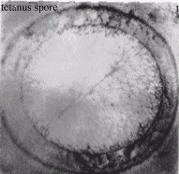
Royal Rife
Cross-section of Single tetanus Spore Dissected with Dr. Rife's
Micromanipulator 25,000x on 35 mm film - Enlarged 227,000x
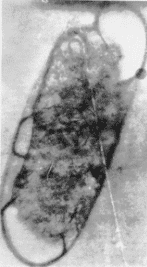
Rife Micrograph of
Bacillus Typhosus (Typhoid) Magnification: 23,000X on 35 mm
film--Enlarged 300,000X.
Rife Discovers the
Cancer Virus
While examining the life bacteria and viruses
through his microscope, Rife thus noticed that each one gave off a
distinct light (or color) pattern. So Rife began to experiment with
instruments he invented that oscillated at the frequencies he had
determined from the organisms (bacteria and viruses) and he discovered
that by playing back their own pattern of oscillation, he could destroy
them without affecting the tissues around them. In other words, Rife
could kill a particular virus or bacterium using electromagnetic rays
alone that were absolutely harmless to the host animal, but deadly to
the microbe.
In the laboratory Rife found two viruses which he
associated with the presence of cancerous tumors. One of these, which he
correlated to carcinoma (Cancer that begins in the skin or in tissues
that line or cover body organs), he called the 'BX virus' The other
virus, correlated to sarcoma (cancer of the connective tissue like bone,
cartilage, fat), he called the 'BY virus'.
Pleomorphism
He also found that bacteria could transform into
cancer causing viruses. Rife implanted his cancer-causing bacteria into
rats. Rife made the startling discovery that the bacteria could change
into a completely different form if the "medium on which they were
living" was slightly altered. In other words, Dr. Rife's cancer causing
substance was, in some forms and in association with some environments
within the body, deadly. But in other forms and in other environments,
benign. His cancer causing substance could be changed back and forth
from one to the other. The implications of this discovery are enormous.
He claimed quite simply that in certain conditions the cancer factor was
inert or neutral, whilst in others it became active.
Pleomorphism was
not a new idea. Already at the time of Pasteur (early 1900's) there was
a heavy debate about whether or not micro-organism could change form,
for example from a virus into a bacteria, sometimes with intermediate
forms. Rife was able to prove that this is indeed the case. Furthermore,
the changing of one form into another was caused by the change in its
environment. Rife said, "In reality, it is not the bacteria themselves
that produce the disease, but the chemical constituents of these
micro-organisms enacting upon the unbalanced cell metabolism of the
human body that in actuality produce the disease. We also believe if the
metabolism of the human body is perfectly balanced or poised, it is
susceptible to no disease." Rife basically classified pathogenic
bacteria into 10 individual groups. He demonstrated that any organism
within its group could be transformed morphologically into any other
organism within the 10 groups by carefully altering the media in which
it was cultured. Of course, this discovery contradicts modern
microbiology which teaches that a bacteria's morphology is fixed and
unchangeable.
Rife observed that pleomorphism happens when the pH
changes in what is now called the field or terrain in the
microorganism's host environment. He considered that the field pH
changes influenced the microorganisms morphing, causing them to become
more pathogenic or more benign depending on the pH factor. This was the
precursor to the field or terrain theory as a source of disease that
many holistic healers now embrace over the germ theory.
Royal Rife Frequency
Machine
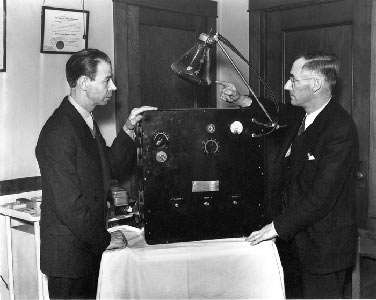
As we mentioned before, Rife discovered that
each microbe resonates at a particular frequency of the electromagnetic
spectrum. By broadcasting this frequency the micro-organism targeted
would start to resonate until it shattered and died. He observed this
through his microscope.
A radio frequency generator would generate a
carrier frequency on which a modulated square wave signal was imposed.
The output from the generator was connected through suitable impedance
matching circuitry to a plasma discharge tube with one or more noble
gases. When the plasma discharge occurred, the tube glowed purplish
blue.
Rife obtained the original Mortal Oscillatory Rates (MOR)
through a painstaking method of tuning the dial of the audio frequency
generator while observing the sample pathogen under his microscope. When
a frequency was discovered that demonstrated the ability to devitalize a
particular microorganism, its dial position was duly noted and marked.
The actual frequencies were determined later after the experimental
trials. By the mid 1950s the verified original MOR frequency list
included 15 different bacteria and viruses.
If you want to know more about Royal Rife and his work check
out the following:
Rife Research Europe,
a very informative good website, no hype.
|

